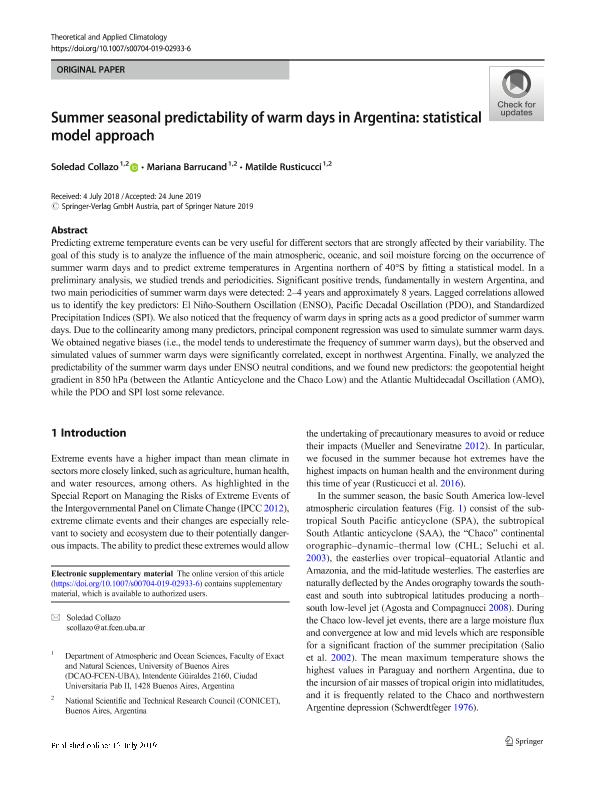Artículo
Summer seasonal predictability of warm days in Argentina: statistical model approach
Fecha de publicación:
07/2019
Editorial:
Springer Wien
Revista:
Theory & Application Climatology
ISSN:
0177-798X
Idioma:
Inglés
Tipo de recurso:
Artículo publicado
Clasificación temática:
Resumen
Predicting extreme temperature events can be very useful for different sectorsthat are strongly affected by their variability. The goal of this study is toanalyze the influence of the main atmospheric, oceanic, and soil moistureforcing on the occurrence of summer warm days and to predict extremetemperatures in Argentina northern of 40°S by fitting a statistical model. In apreliminary analysis, we studied trends and periodicities. Significant positivetrends, fundamentally in western Argentina, and two main periodicities ofsummer warm days were detected: 2?4 years and approximately 8 years.Lagged correlations allowed us to identify the key predictors: ElNiño-Southern Oscillation (ENSO), Pacific Decadal Oscillation (PDO), andStandardized Precipitation Indices (SPI). We also noticed that the frequency ofwarm days in spring acts as a good predictor of summer warm days. Due to thecollinearity among many predictors, principal component regression was usedto simulate summer warm days. We obtained negative biases (i.e., the modeltends to underestimate the frequency of summer warm days), but the observedand simulated values of summer warm days were significantly correlated,except in northwest Argentina. Finally, we analyzed the predictability of thesummer warm days under ENSO neutral conditions, and we found newpredictors: the geopotential height gradient in 850 hPa (between the AtlanticAnticyclone and the Chaco Low) and the Atlantic Multidecadal Oscillation(AMO), while the PDO and SPI lost some relevance.
Archivos asociados
Licencia
Identificadores
Colecciones
Articulos(OCA CIUDAD UNIVERSITARIA)
Articulos de OFICINA DE COORDINACION ADMINISTRATIVA CIUDAD UNIVERSITARIA
Articulos de OFICINA DE COORDINACION ADMINISTRATIVA CIUDAD UNIVERSITARIA
Citación
Collazo, Soledad Maribel; Barrucand, Mariana Graciela; Rusticucci, Matilde Monica; Summer seasonal predictability of warm days in Argentina: statistical model approach; Springer Wien; Theory & Application Climatology; 138; 3; 7-2019; 1853-1876
Compartir
Altmétricas




